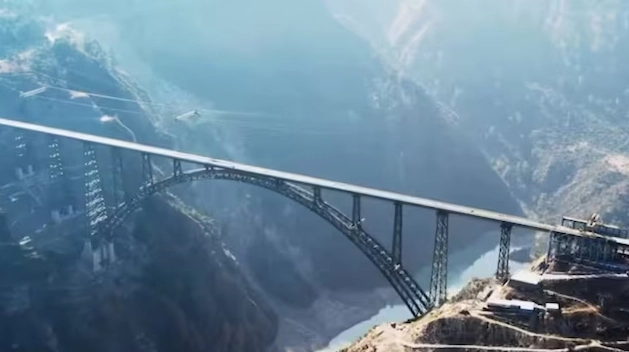
Prime Minister Narendra Modi will inaugurate the Chenab Bridge in Jammu and Kashmir, the world’s highest railway arch structure, on June 6.
The bridge, an engineering marvel located in the Reasi district of Jammu and Kashmir, is a critical component of a much larger and strategically vital infrastructure project.
PM Modi is also expected to flag off two specially designed Vande Bharat trains connecting Srinagar with Katra in Jammu on the same day.
A previous inauguration of the Chenab Bridge in April was postponed due to weather conditions.
Why is the bridge so important?
The Chenab Bridge is a key link in the 272-km USBRL project, which aims to connect the Kashmir Valley with the rest of India’s railway network. It was declared a “National Project" in 2002 due to its great importance.
The bridge specifically connects Bakkal and Kauri across the deep gorge of the Chenab River.
Standing at an astounding 359 metres (1,178 feet) above the Chenab riverbed, it is the world’s highest railway bridge. To put this in perspective, it’s about 35 metres taller than the Eiffel Tower in Paris.
This incredible height also presented unprecedented engineering challenges.
The construction of the Chenab Bridge was a monumental undertaking, battling extremely difficult conditions.
The bridge is built in a seismically active and geologically complex region of the Himalayas with unstable rock slopes, folds, faults, and a high risk of landslides.
It is designed to withstand high wind speeds (up to 266 km/h) and extreme temperatures ranging from -20°C to +45°C.
Given the sensitive nature of the region, the bridge is made of blast-proof steel, designed in consultation with the Defence Research and Development Organisation (DRDO), making it highly resilient to potential threats.
The main arch, made of steel, was erected using a sophisticated cable crane system, with segments being lifted and bolted together. The total length of the bridge is 1,315 metres, and it used approximately 28,660 tonnes of steel and 66,000 cubic metres of concrete.
Historically, Kashmir’s connectivity to the rest of India has been reliant on treacherous roads, often cut off by snow, landslides, and adverse weather conditions. The Chenab Bridge, as part of the USBRL, provides all-weather, reliable transportation, eliminating the disruptions caused by harsh Himalayan winters.
It also significantly reduces travel time for both passengers and goods.
Beyond civilian benefits, the bridge holds immense strategic significance as it allows for faster movement of defence personnel and equipment to border areas, strengthening national security in a sensitive region, particularly after the April 22 Pahalgam terror attack and the subsequent face-off between India and Pakistan.
The bridge is capable of handling heavy artillery transport.
It also symbolises a deeper message of uniting the Kashmir Valley with the rest of India, fostering greater national integration.
The rail link is expected to be a transformative engine for economic growth in Jammu and Kashmir. For instance, easier and more reliable access will significantly boost tourism.
Farmers and traders can transport their produce (like apples and dry fruits) to wider markets more quickly, reducing costs and increasing profits.
The railway operations and maintenance will generate new jobs and opportunities for skill training for the local youth.
Improved connectivity means better access to education, healthcare, and essential supplies for the local population.